Everyone’s skin is different and so is it's sensitivity toward different allergens. However, oatmeal is one natural ingredient that can serve all skin types when you have an allergic reaction; unless you are allergic to oats itself.
A skin allergy is typically your immune system’s response to a foreign body or substance that manifests in the form of itching, swelling, redness or a rash. It can be pretty bothersome if the rash appears on your face.
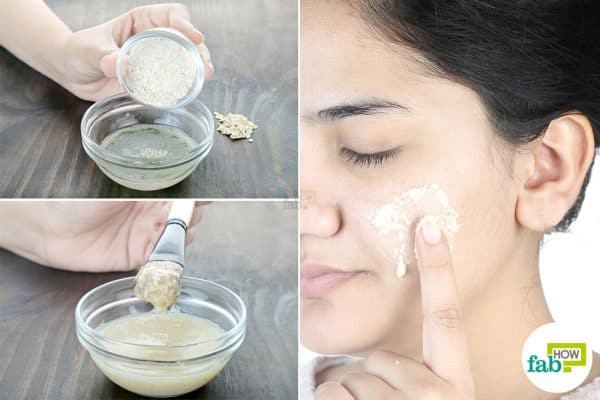
Oatmeal, being rich in avenanthramides (a group of phenolic alkaloids), works as an anti-inflammatory to bring down the swelling and irritation in a rash. Oatmeal also contains saponins that work as natural skin cleansers.
It is for this reason that colloidal oatmeal or oatmeal extracts are used in lotions, scrubs and face masks, especially those for sensitive skin. Oatmeal can also bring immense relief from skin conditions, such as eczema, psoriasis, rosacea, and hyperpigmentation.
However, you need not invest in pricey products when you can whip up your own anti-allergic face pack. All you need is some colloidal oatmeal (finely ground oats) and a couple of skin-soothing and nourishing ingredients.
Contents
Oatmeal Face Mask Recipes for Allergies and Rashes
If you are troubled with a nasty rash on your face or dealing with any allergic skin diseases, our five best oatmeal face masks for rashes and allergies can help return your skin to normal. (And these packs are not just meant for the face, they can be used anywhere on your body to soothe irritated skin.)
Method 1: Oatmeal & Egg White Mask
Egg whites are great for your skin. Being rich in vitamins and minerals, they help replenish your skin with nutrients for a faster recovery. Egg whites also help shrink the pores and tighten your skin to make it appear younger.
A combination of oatmeal and egg whites helps form a protective barrier on the irritated skin and bring down the inflammation quickly.
This oatmeal face mask for rashes and allergies contains olive oil that deeply moisturizes itchy skin. A 2016 study also compares the use of olive oil and sunflower oil for neonatal skin hydration. (1)
Things you’ll need:
- Colloidal oatmeal (anti-inflammatory) – 1 tablespoon
- Egg whites (forms a protective barrier) – 1 egg
- Olive oil (antioxidant) – 1 tablespoon
Step 1. Whisk up the whites from 1 egg

- Break open an egg and collect the egg whites in a bowl. If you need help, check out our hacks to separate egg whites from the yolk.
- Use a motorized blender to whisk up the egg whites until it turns frothy.
Step 2. Mix in the oatmeal and olive oil

- Add 1 tablespoon of colloidal oatmeal to the egg whites.
- Add 1 tablespoon of olive oil as well.
- Whisk up everything to get a smooth blend.
Step 3. Apply the mask daily
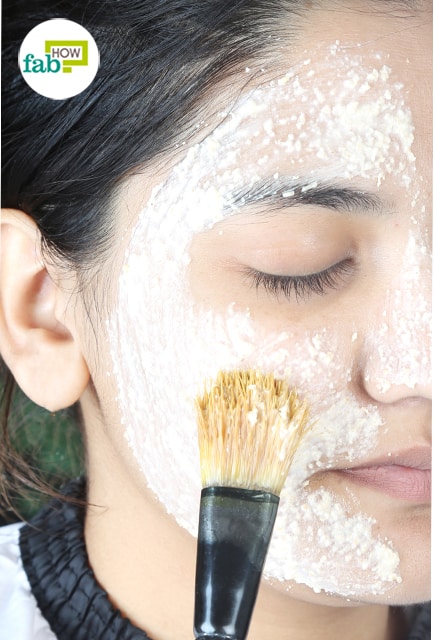
- Use an applicator brush to apply an even layer of the blend on your face.
- Leave it on for 15 minutes, then rinse it off with cold water.
- Apply a light moisturizer.
Repeat once daily for 4 or 5 days, or until your skin condition improves.
Method 2: Oatmeal, Milk & Honey Mask
Another soothing mask, especially for sensitive skin, is a combination of milk, honey, and oatmeal.
While the oatmeal helps reduce the skin irritation, the milk works as a natural cleanser to remove any impurities on the skin. The lactic acid in the milk also kills any microbes that may be causing the rash.
The honey helps moisturize your itchy inflamed skin without turning it oily. Upon contact with skin, it also releases hydrogen peroxide that further disinfects the skin to control the allergic reaction. (2)
Things you’ll need:
- Colloidal oatmeal (anti-inflammatory) – 1 tablespoon
- Raw honey (moisturizes and disinfects skin) – 2 teaspoons
- Milk (cleanses skin) – enough to form a paste
Step 1. Combine the three ingredients

- Put 1 tablespoon of colloidal oatmeal in a bowl.
- Add 2 teaspoons of raw honey to it.
- Add enough milk to form a spreadable paste.
Step 2. Mix well & apply the face pack daily
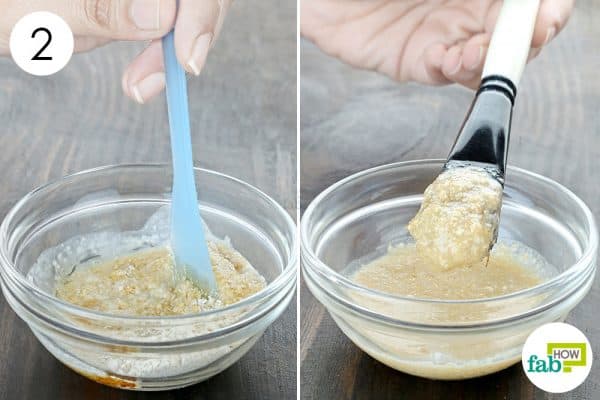
- Blend all the ingredients thoroughly into a smooth paste.
- Use a clean applicator brush to apply the blend on your face.
- Wait 20 minutes, then wash it off with warm water and a mild cleanser.
- Apply a light moisturizer.
Apply this mask once daily for 4 or 5 days to soothe your irritated skin.
Method 3: Oatmeal & Coconut Oil Mask
Oatmeal can also be combined with coconut oil and applied as a face mask to get rid of toxins causing an allergic reaction and flare-ups in skin conditions.
Coconut oil is a natural antibacterial and antifungal agent that kills microbes and forms a protective layer on the skin. (3) The saponins in oatmeal help cleanse the skin pores. Being one of the best oatmeal face masks for rashes and allergies, it helps restore the moisture to your skin and promote faster healing. (4)
Things you’ll need:
- Colloidal oatmeal (anti-inflammatory) – 1½ tablespoons
- Extra-virgin coconut oil (antimicrobial, forms a protective barrier) – ½ tablespoon
- Warm water – 2 tablespoons
Step 1. Combine the three ingredients

- Pour 2 tablespoons of warm water into a bowl.
- Add ½ tablespoon of extra-virgin coconut oil.
- Stir until the oil melts completely.
- Add 1½ tablespoons of colloidal oatmeal.
Step 2. Mix well & apply it as a face mask daily

- Mix well to form a lump-free paste. Let it sit for 1 to 2 minutes to cool down completely.
- Use a clean applicator brush to apply the blend on your entire face.
- Leave it on for 15 minutes, then massage the blend in circular motions for 5 minutes.
- Rinse it off with lukewarm water. Splash some cold water on your face afterward to seal the skin pores.
- Pat your skin dry and apply an oil-free moisturizer.
Apply the face mask once daily until your skin is restored to normal.
Method 4: Oatmeal & Aloe Vera Mask
Combining oatmeal and fresh aloe vera gel makes an extremely soothing face mask for rashes and allergies.
The clear gel derived from aloe vera leaves helps cool down the skin and forms an antimicrobial layer on it to prevent any rash from spreading. (5) Aloe vera is also loaded with minerals and vitamins that aid faster recovery and help revitalize dull skin. Here's how you can store fresh aloe vera gel and use it to make this simple oatmeal face mask for rashes and allergies.
Things you’ll need:
- Colloidal oatmeal (anti-inflammatory) – ½ tablespoon
- Fresh aloe vera gel (antimicrobial, anti-inflammatory) – ½ tablespoon
Step 1. Combine the two ingredients

- Put a ½ tablespoon of colloidal oatmeal in a container.
- Add ½ tablespoon of fresh aloe vera gel. If you need help, check out our article on how to extract fresh aloe vera gel.
Step 2. Mix well & apply the blend daily
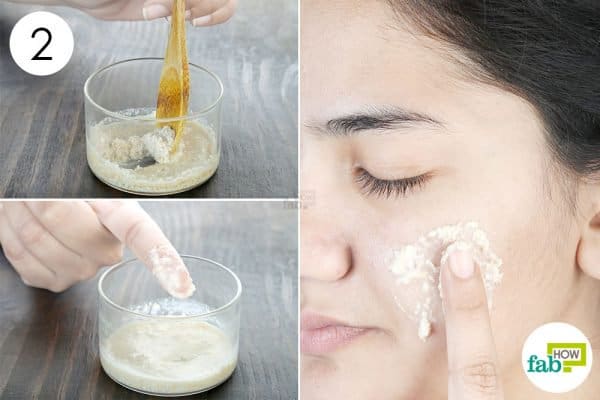
- Use a spoon to blend the ingredients well.
- Use a clean finger to massage the blend over the affected area, or apply it over your entire face.
- Leave it for 5 minutes, then rinse it off with water.
- Pat your skin dry and apply a light moisturizer.
Use it once or twice every day until the inflammation subsides.
Method 5: Oatmeal & Apple Cider Vinegar Mask
No home remedy list is complete without some apple cider vinegar in it. Even when it comes to dealing with skin allergies, apple cider vinegar can be combined with oatmeal to form an effective face mask for rashes and allergies.
Apart from its benefit for beautiful skin and hair, it's anti-inflammatory properties help bring down the inflammation in the affected skin. It is also antimicrobial and will take care of any invading microbe that is causing the allergic reaction or flare-up. Apple cider vinegar also helps normalize your skin’s pH.
This face mask also uses unsweetened apple juice that helps further moisturize your skin.
Things you’ll need:
- Colloidal oatmeal (anti-inflammatory) – ½ tablespoon
- Raw, unfiltered apple cider vinegar (normalizes the skin’s pH) – ½ teaspoon
- Apple juice, unsweetened (moisturizes skin) – enough to form a paste
Step 1. Combine the three ingredients
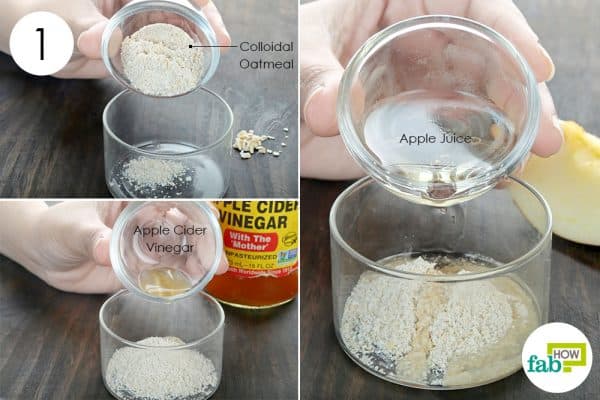
- Put a ½ tablespoon of colloidal oatmeal in a container.
- Add ½ teaspoon of raw, unfiltered apple cider vinegar to it.
- Add enough unsweetened apple juice to form a paste.
Step 2. Mix well & apply it on your face twice a week

- Use a spoon to blend the ingredients well.
- Apply a thin layer of the paste on your entire face.
- Let it sit until the paste dries completely.
- Wash it off with lukewarm water and pat your skin dry.
- Apply a light moisturizer.
Use this mask 2 or 3 times a week to treat your inflamed skin.
Tips to keep in mind
- You can also try our homemade oatmeal face masks for blackheads and whiteheads.
- In fact, there’s a number of ways you can use oatmeal to get beautiful skin and hair.
- Oatmeal serves as an excellent exfoliant and can be used to maintain soft hands.
Resources:
- Cooke A, Cork MJ, Victor S, et al. Olive Oil, Sunflower Oil or no Oil for Baby Dry Skin or Massage: A Pilot, Assessor-blinded, Randomized Controlled Trial (the Oil in Baby SkincaRE [OBSeRvE] Study). Acta Dermato-Veneriologica. https://www.ncbi.nlm.nih.gov/pubmed/26551528. Published March 2016.
- Alangari AA, Morris K, Lwaleed BA, et al. Honey is potentially effective in the treatment of atopic dermatitis: Clinical and mechanistic studies. The Canadian Journal of Chemical Engineering. https://onlinelibrary.wiley.com/doi/full/10.1002/iid3.153. Published March 30, 2017.
- Evangelista MT, Abad-Casintahan F, Lopez-Villafuerte L. The effect of topical virgin coconut oil on SCORAD index, transepidermal water loss, and skin capacitance in mild to moderate pediatric atopic dermatitis: a randomized, double-blind, clinical trial. International Journal of Dermatology. https://www.ncbi.nlm.nih.gov/pubmed/24320105. Published January 2014.
- Cerio R, Dohil M, Jeanine D, Magina S, Mahé E, Stratigos AJ. Mechanism of action and clinical benefits of colloidal oatmeal for dermatologic practice. Journal of Drugs in Dermatplogy. https://www.ncbi.nlm.nih.gov/pubmed/20865844. Published September 2010.
- Dawid-Pać R. Medicinal plants used in the treatment of inflammatory skin. Advances in Dermatology and Allergology. https://www.ncbi.nlm.nih.gov/pmc/articles/PMC3834722/. Published June 20, 2013.






